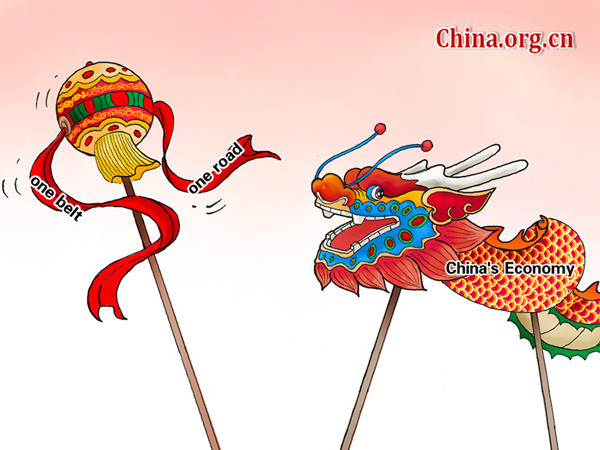Key strategic significance of One Belt and One Road
- By John Ross
 0 Comment(s)
0 Comment(s) Print
Print E-mail China.org.cn, March 5, 2015
E-mail China.org.cn, March 5, 2015
|
[By Zhai Haijun/China.org.cn] |
One of the key recent policies launched by China is the One Belt and One Road initiatives announced by President Xi Jinping. As this simultaneously combines both economic and diplomatic aspects, it provides an important part of the international context for discussion at the current NPC and CPPCC sessions. But the strategic importance of the One Belt and One Road policy should not be seen as a short term or specific tactical policy by China. Its significance can be particularly clearly understood in the context of current key trends in the global economy.
Globalization remains the overall trend in the world economy. But it is important to be clear that globalization is not an even or undifferentiated international process. In particular, geographical proximity continues to play a significant role in shaping economies.
Within the overall framework of rising world trade it is striking that the development of international division of labour has now reached a point where the "classic" sized nation state, on a scale which dominated Europe in the 19th and most of the 20th centuries (Germany, U.K., France), and which exists in large parts of Asia (Thailand, Malaysia, Cambodia) is too small by itself to constitute a sufficiently developed economic unit. This trend itself creates globalization. But instead of a fully "equalized" global economy being created, in which geography does not play a significant role, there is an emerging division into "continental scale" economic units which are replacing "national" ones.
To adapt the terminology of a well-known book, Thomas Friedman was therefore exaggerating in declaring that "The World is Flat." Instead the world is still divided into a number of economic "nexuses" but these are now continental rather than national in size – and are relatively well connected. This global context casts clear light on the One Belt and One Road initiative.
To clarify the original historical starting point of these current economic processes, it is sometimes mistakenly believed that because the United States is not only the world's largest economy, but also has the highest per capita GDP of any major economy, the decisive factor in U.S. economic supremacy is its superior productivity level. This is easily shown to be numerically false. Measured in Parity Purchasing Powers (PPPs) U.S. per capita GDP is 22 percent higher than Germany, a significant but not overwhelmingly lead. At current exchange rates, the gap is narrower at 18 percent. But the U. S. population is 380 percent of that of Germany.
The fact the United States is a much larger country than Germany therefore plays, and historically played, a much greater role in the United States' economic superiority compared to Germany than does the United States' relative advantage in productivity. In political terms the United States is a "nation state" but its size means the United States constitutes a "continental scale" economy.
Seen from this angle, of the historical trend to the creation of "continental scale" economies, the development taking place in the key areas of the world is evident:
? The United States was the world's first continental scale economy;
? The USSR was the second (ultimately failed) continental scale economy – it remains to be seen how much of the former USSR will be reintegrated in the Eurasian Economic Union vision of Putin;
? China is, as with the United States, in political terms a nation state but also history's third continental scale economy;
? India is the fourth continental economy,
? If it succeeds in integrating itself fully, the European Union will be the fifth continental economy.
It is also clear that to gain the advantages of international division of labour, international trade, and other factors, the most successful of these "continental economies" have a tendency to integrate themselves with surrounding regions even in cases where political union is not posed. The United States has therefore created very strong economic links with Mexico and Canada, formalized in the North American Free Trade Agreement (NAFTA). The EU has progressively expanded from its original six-member West European nucleus to form an integrated European economic zone including 28 member states and several closely associated ones.






